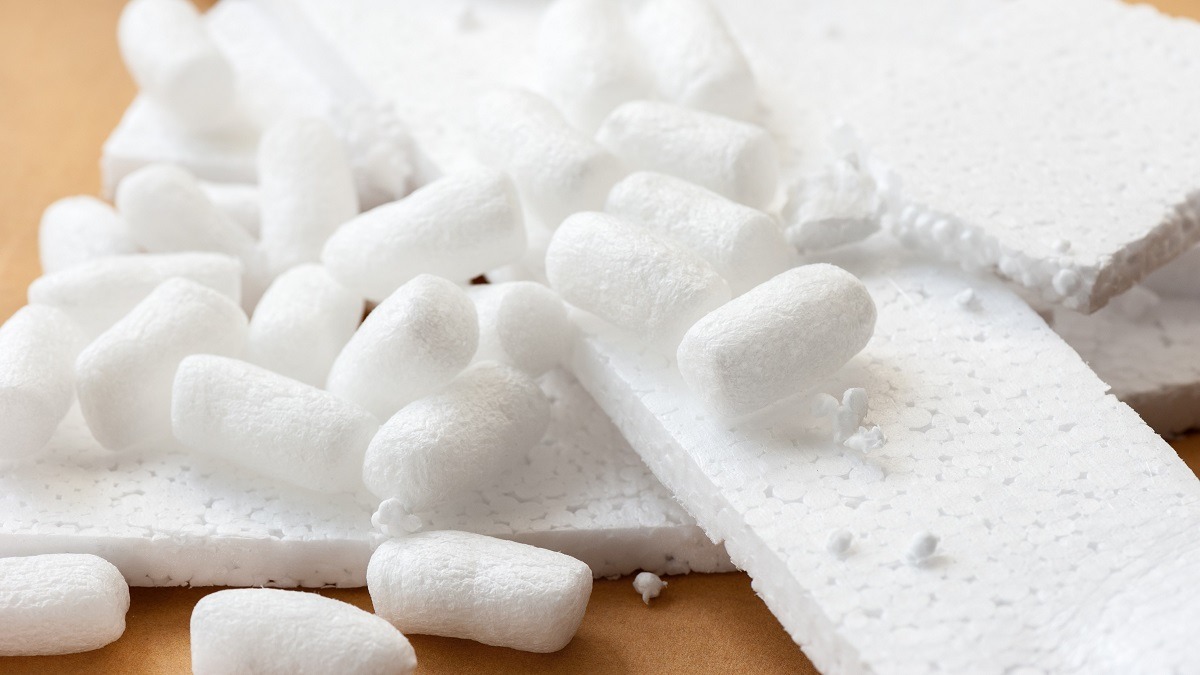It’s the eternal question: Can I recycle expanded polystyrene (commonly known by the brand name Styrofoam)?
Expanded polystyrene (EPS) is everywhere: It holds your food, secures items in packages, provides insulation in homes, and even helps protect your head in your bike helmet. It’s designated by the plastic recycling code #6 PS, which (in unexpanded form) you’ll find in plastic cups and CD and DVD cases.
Here’s a sobering fact: Americans dump approximately 1,500 tons of polystyrene in landfills daily, and less than 1% of it is recycled. That recycling rate is particularly disheartening when you consider that EPS is 98% air, making it technically recyclable—yet most communities lack the equipment and infrastructure to process it economically.
Here’s the Problem
Even if your community recycles plastic #6, it may not accept expanded polystyrene. That’s because EPS is an end product, and you can’t un-expand the plastic resin. However, facilities that are equipped to process EPS can grind it for use in other applications.
Polyethylene foam is technically recyclable, but may not be accepted locally because the recyclers lack the equipment to process it. Because it’s so lightweight, EPS accounts for only 0.01% of the total municipal solid waste stream by weight, but, as you may have guessed, its volume is a greater problem than its weight. It takes up space in landfills and doesn’t biodegrade.
The recycling challenge has become so significant that several states have enacted bans on EPS foam packaging and products. As of 2025, Oregon, California, Delaware, Rhode Island, Hawaii, and Washington have enacted legislation prohibiting various EPS products, including food service containers and packing peanuts. These bans reflect growing concern about the material’s environmental persistence and the microplastics it generates.
Recycling and Reusing EPS
While curbside recycling of expanded polystyrene is limited, recycling markets and innovative solutions are emerging. The form your EPS takes is the biggest factor that determines how to get rid of it. EPS packaging, especially packing peanuts, is often accepted at shipping stores for reuse, but these locations won’t take large blocks used in packaging, your to-go containers, or cups.
Drop-off sites
Earth911 Recycling Search can help you find polystyrene recycling in your area. Make sure to call local sites in advance to make sure EPS is accepted and in what form. If they do take EPS, most accept packing materials but not food or medical containers. The EPS Industry Alliance maintains a directory of EPS recycling companies, including businesses where you can drop off the material and those that will pick it up curbside. Make sure all containers are clean, empty, and free of tape, labels, plastic film, or other contamination. Contaminants can ruin the recycling process.
Innovative Community Solutions
Exciting new technologies are making EPS recycling more accessible and economical. Foam Cycle has developed a self-service foam collection and recycling system that fits in a shipping container and can be installed at municipal transfer stations or community locations (listen to an interview with the founder). These systems process the foam on-site and have proven economically viable, breaking even in four to five years. A ton of the processed resin sells for between $300 and $500.
For communities looking for mobile solutions, innovative recycling systems like the Styro-Constrictor and Styro-Portapactor travel from location to location, densifying foam on-site. These mobile units reduce EPS volume by 90% and eliminate the need for costly brick-and-mortar recycling facilities, making the process more affordable than landfilling.
Mail-back
If a drop-off site doesn’t exist in your area, Terracycle offers a prepaid mail-in Zero Waste Box designed for EPS food packaging. At this time, we are not aware of any mail-in programs that accept large blocks of Styrofoam.
Reuse for loose fill
What about packing peanuts? Their simplest reuse is in another package you need to ship. You can also donate them to The UPS Store outlets or other shipping stores, which will gladly reuse clean packing peanuts. Not sure where to go? The EPS Industry Alliance has real people answering questions about local options at 800-828-2214.
Large volume
Working with a recycling company for pick-up service is best if your business receives large amounts of EPS. Company requirements for storage and equipment vary, but it’s typical for storage containers to remain outdoors in a bin where EPS is kept clean, dry, and unexposed to the elements. It is wise to check with the company to see how they accept EPS, whether it be stacked, bagged, baled, or condensed.
If your business routinely handles large EPS pieces, look for devices from companies like RecycleTech or StyroMelt that reduce EPS volume for large-scale recycling.
EPS Alternatives
As more governments consider and implement EPS bans and businesses phase out EPS foam packaging, you’ll likely start seeing alternatives. You can already find food packaging made from bamboo, cornstarch, mushrooms, and peat plastic, not to mention plantable packaging.
The wave of state-level bans is accelerating this transition, with California’s SB54 requiring that all plastic food packaging be recyclable and that manufacturers demonstrate that 25% of their material is recycled to continue operating in the state.
If costs dictate that you continue using expanded polystyrene, try to purchase EPS made from recycled content. Usually, green packing peanuts are made with a high recycled content, so if you ship a lot of material, spring for the off-white color EPS for your packages.
Editor’s Note: Originlly published on March 9, 2014, this article was most recently updated in October 2025 with current statistics, state ban information, and new recycling solutions.
Source link
Earth911 earth911.com

